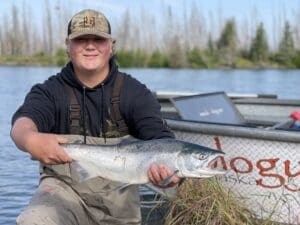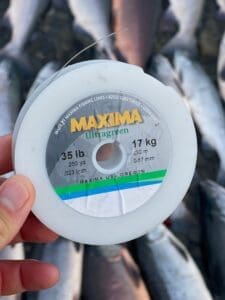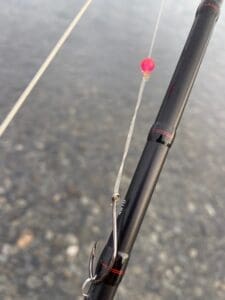Now that we’ve discussed the basic rigging options for gear types, hook choices, knots to use, and sinker options – it’s time to put it all together and rig your rod so that it’s ready for action!
If you’re going to be wielding a fly rod with fly line, then you’re going to want to start with a pretty heavy leader or “butt section” attached to your fly line. I recommend 40lb test monofilament attached with the nail-less nail knot that we learned in an earlier blog found HERE. Anywhere from 4 to 6 feet is typically the right amount of line to use. If you use too little line here then your fly line will drag in the current too much, so don’t go too short or your hook-ups may decrease dramatically. Pro-tip: make sure your knot is tied clean and your tag ends are clipped short so that the nail-less nail knot can easily pass through your guides without getting stuck.
If you’re using a conventional rod, or a fly rod with monofilament line in lieu of fly line, then main line in the 30-40 lb. range is a good choice. This may seem like heavy line for a 5-10lb fish, but this isn’t your average 5-10 pound fish! With sockeye, your gear gets heavy use and the fish are strong, acrobatic, and really know how to use the current to their advantage. Later, probably in the heat of battle, you’ll remember this and thank me for recommending 30+ lb. test :)
The rest of your system/leader from the weight to the hook will be rigged the same whether you’re choosing a fly rod & reel with fly line, a fly rod & reel with monofilament main line, or conventional gear…
The next step is to attach your weight system and my favorite method is with a 3-way swivel, a clip, and a bell sinker which are pictured and discussed in the previous blog about weights & sinkers found HERE. I prefer to use a Palomar knot to attach the 3-way swivel. Remember, the size of the bell sinker should be chosen according to the flows, depth, and type of bank you’re fishing. You’ll generally want to go slightly heavier when fishing a cut bank, and slightly lighter when fishing a gentle sloping gravel bar. Mess around with different sizes until you really get it dialed in as this is questionably the most important factor (other than presence of fish) that determines your success at hooking up!
For your leader, I prefer 35lb test Maxima Ultragreen monofilament line, and my leader length ranges from 6-9 feet depending on the water conditions and angler ability. Leader length is another factor that you can experiment with and you’ll often find that a little shorter or longer will make a big difference from spot to spot. I typically attach my leader to the bottom of the 3-way swivel with an improved clinch knot.
At the end of my leader I really like a 3/0 Gamakatsu Light hook rigged with a double surgeon’s loop knot. I will change my hook size and type depending on flows (bigger/heavier gauge as flows increase) and personal preference comes into play a lot here. I will add a small bead above my knot if regulations mandate it, but a bare hook presented properly works just as well as anything when allowed.
Voila! In my mind we just created the perfect sockeye rig… But as you might imagine, even the perfect rig won’t catch many fish if it’s not presented correctly. We’ll discuss presentation in the next blog coming sooooooooon….
As always, please share your input, opinions, and/or questions you might have about any of this!






Think you are right on target
I have a couple of Okuma rigs but would love to find a Kenai red rod. No luck so far…any suggestions
They sell the Kenai red rods at Trustworthy Hardware in Soldatna Alaska. Saw them there this summer. You may be able to have them ship it to you if they have them this time of the year.